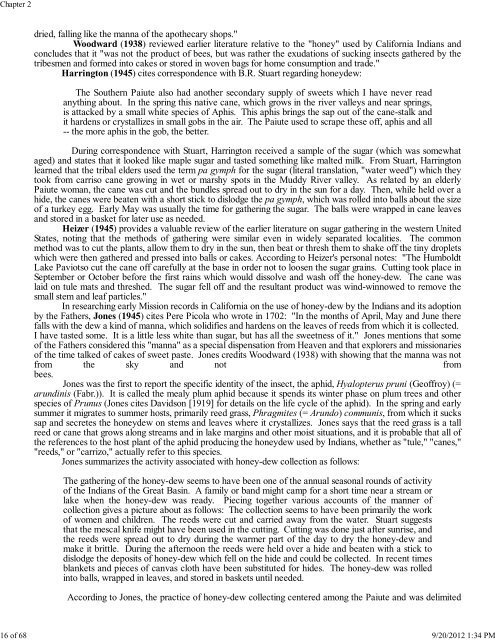Chapter 2. Insect Foods of North American Indigenous Populations ...
Chapter 2. Insect Foods of North American Indigenous Populations ...
Chapter 2. Insect Foods of North American Indigenous Populations ...
You also want an ePaper? Increase the reach of your titles
YUMPU automatically turns print PDFs into web optimized ePapers that Google loves.
<strong>Chapter</strong> 216 <strong>of</strong> 68 9/20/2012 1:34 PMdried, falling like the manna <strong>of</strong> the apothecary shops."Woodward (1938) reviewed earlier literature relative to the "honey" used by California Indians andconcludes that it "was not the product <strong>of</strong> bees, but was rather the exudations <strong>of</strong> sucking insects gathered by thetribesmen and formed into cakes or stored in woven bags for home consumption and trade."Harrington (1945) cites correspondence with B.R. Stuart regarding honeydew:The Southern Paiute also had another secondary supply <strong>of</strong> sweets which I have never readanything about. In the spring this native cane, which grows in the river valleys and near springs,is attacked by a small white species <strong>of</strong> Aphis. This aphis brings the sap out <strong>of</strong> the cane-stalk andit hardens or crystallizes in small gobs in the air. The Paiute used to scrape these <strong>of</strong>f, aphis and all-- the more aphis in the gob, the better.During correspondence with Stuart, Harrington received a sample <strong>of</strong> the sugar (which was somewhataged) and states that it looked like maple sugar and tasted something like malted milk. From Stuart, Harringtonlearned that the tribal elders used the term pa gymph for the sugar (literal translation, "water weed") which theytook from carriso cane growing in wet or marshy spots in the Muddy River valley. As related by an elderlyPaiute woman, the cane was cut and the bundles spread out to dry in the sun for a day. Then, while held over ahide, the canes were beaten with a short stick to dislodge the pa gymph, which was rolled into balls about the size<strong>of</strong> a turkey egg. Early May was usually the time for gathering the sugar. The balls were wrapped in cane leavesand stored in a basket for later use as needed.Heizer (1945) provides a valuable review <strong>of</strong> the earlier literature on sugar gathering in the western UnitedStates, noting that the methods <strong>of</strong> gathering were similar even in widely separated localities. The commonmethod was to cut the plants, allow them to dry in the sun, then beat or thresh them to shake <strong>of</strong>f the tiny dropletswhich were then gathered and pressed into balls or cakes. According to Heizer's personal notes: "The HumboldtLake Paviotso cut the cane <strong>of</strong>f carefully at the base in order not to loosen the sugar grains. Cutting took place inSeptember or October before the first rains which would dissolve and wash <strong>of</strong>f the honey-dew. The cane waslaid on tule mats and threshed. The sugar fell <strong>of</strong>f and the resultant product was wind-winnowed to remove thesmall stem and leaf particles."In researching early Mission records in California on the use <strong>of</strong> honey-dew by the Indians and its adoptionby the Fathers, Jones (1945) cites Pere Picola who wrote in 1702: "In the months <strong>of</strong> April, May and June therefalls with the dew a kind <strong>of</strong> manna, which solidifies and hardens on the leaves <strong>of</strong> reeds from which it is collected.I have tasted some. It is a little less white than sugar, but has all the sweetness <strong>of</strong> it." Jones mentions that some<strong>of</strong> the Fathers considered this "manna" as a special dispensation from Heaven and that explorers and missionaries<strong>of</strong> the time talked <strong>of</strong> cakes <strong>of</strong> sweet paste. Jones credits Woodward (1938) with showing that the manna was notfrom the sky and not frombees.Jones was the first to report the specific identity <strong>of</strong> the insect, the aphid, Hyalopterus pruni (Ge<strong>of</strong>froy) (=arundinis (Fabr.)). It is called the mealy plum aphid because it spends its winter phase on plum trees and otherspecies <strong>of</strong> Prunus (Jones cites Davidson [1919] for details on the life cycle <strong>of</strong> the aphid). In the spring and earlysummer it migrates to summer hosts, primarily reed grass, Phragmites (= Arundo) communis, from which it suckssap and secretes the honeydew on stems and leaves where it crystallizes. Jones says that the reed grass is a tallreed or cane that grows along streams and in lake margins and other moist situations, and it is probable that all <strong>of</strong>the references to the host plant <strong>of</strong> the aphid producing the honeydew used by Indians, whether as "tule," "canes,""reeds," or "carrizo," actually refer to this species.Jones summarizes the activity associated with honey-dew collection as follows:The gathering <strong>of</strong> the honey-dew seems to have been one <strong>of</strong> the annual seasonal rounds <strong>of</strong> activity<strong>of</strong> the Indians <strong>of</strong> the Great Basin. A family or band might camp for a short time near a stream orlake when the honey-dew was ready. Piecing together various accounts <strong>of</strong> the manner <strong>of</strong>collection gives a picture about as follows: The collection seems to have been primarily the work<strong>of</strong> women and children. The reeds were cut and carried away from the water. Stuart suggeststhat the mescal knife might have been used in the cutting. Cutting was done just after sunrise, andthe reeds were spread out to dry during the warmer part <strong>of</strong> the day to dry the honey-dew andmake it brittle. During the afternoon the reeds were held over a hide and beaten with a stick todislodge the deposits <strong>of</strong> honey-dew which fell on the hide and could be collected. In recent timesblankets and pieces <strong>of</strong> canvas cloth have been substituted for hides. The honey-dew was rolledinto balls, wrapped in leaves, and stored in baskets until needed.According to Jones, the practice <strong>of</strong> honey-dew collecting centered among the Paiute and was delimited
















